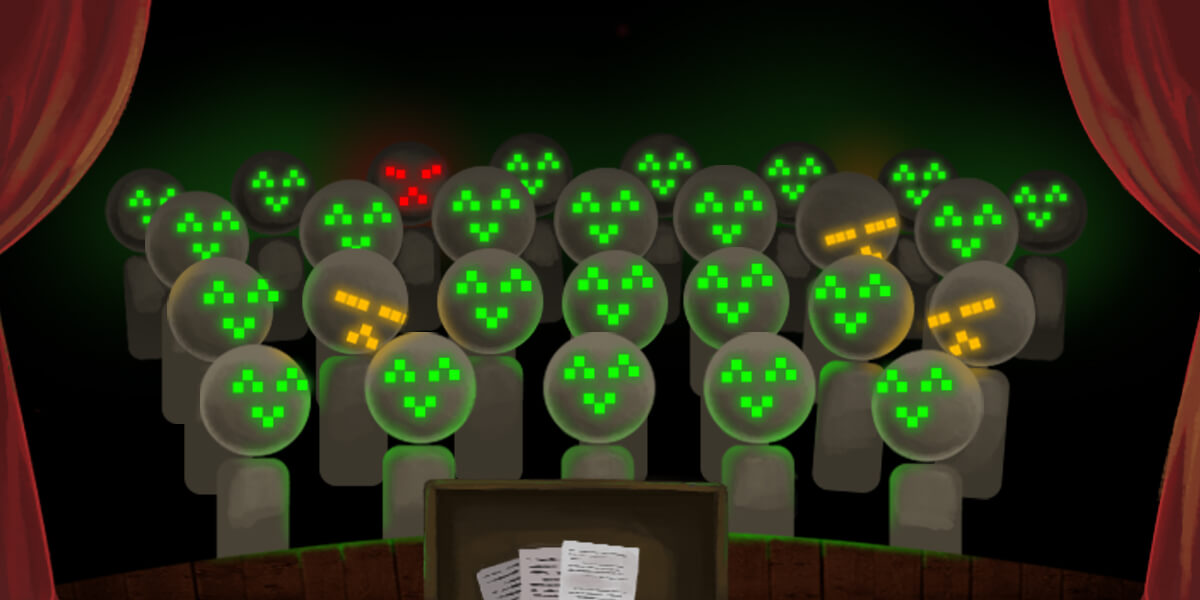
Simulated image of a virtual audience reacting to a prompt (Photo/Victoria Cuthbertson)
You look out into the crowd. The audience is staring back at you.
You nervously start to stumble through your words under the stress of their eyes drilling into your skin. You lose your train of thought, drop your note cards from your shaking hands, brace yourself for the laughs you know are going to echo up to you onstage.
But the laughter never comes.
That’s when your remember: the audience isn’t real. You are speaking to a virtual audience whose sole purpose is to react to your performance in a non-threatening fashion to help you improve your public speaking ability.
With this in mind, you get your presentation back on track and finish up to general approval from your virtual avatars.
Sound far-fetched? It’s not.
This is Cicero, a program currently under design by Stefan Scherer and Mathieu Chollet of the USC Institute for Creative Technologies. Cicero, named after the famed Roman orator, is a project designed to help people overcome the fear and anxiety typically associated with public speaking.

USC Viterbi’s Stefan Scherer (Photo/Will Taylor)
“Public speaking is threatening to many people,” said Scherer, also a USC research assistant professor in the Department of Computer Science. “People often have anxiety in these situations, so we wanted to see if we could use virtual humans to create a less threatening, more safe environment.”
Cicero works with virtual reality glasses that have the effect of immersing the participant fully in the virtual world to make it as real as possible. In the virtual world, animated avatars that look like real people are coded to react to the speaker. Feedback then depends on the speaker’s aptitude. If they are interesting, the audience will appear engaged: lean forward, display interested facial expressions, nod their heads, etc. If the speaker fails to engage the assembly, audience members will demonstrate their dissatisfaction by leaning back, looking disinterested, shaking their heads, etc.
Scherer was drawn to public speaking because of its relevance and its one-sided nature.
“The audience doesn’t generally speak to you so you don’t have to author responses or a conversation itself,” Scherer said.
The team’s research on Cicero began in 2013, and its funding came from the National Science Foundation (NSF). The ICT team has created several avatars, coded by Chollet, that have about 1,000 different reactions. Their plan is to code the avatars to react to nonverbal cues, such as the presenter’s facial expression, their volume, or their body language..
Cicero isn’t quite ready for commercialization, but Scherer and his team anticipate a wide range of uses for it. Their original intent for Cicero was to improve someone’s public speaking skills. That’s because the virtual avatars are intended to be seen as a less threatening, practice audience for someone with a fear of public speaking.
“Being exposed to a real audience where you feel judged, in front of that environment you could rehearse and expose yourself to the anxiety-inducing environment one step at a time,” said Chollet, a postdoctoral researcher at USC ICT.
However, their research now has broader implications, specifically for those suffering from schizophrenia. Social interaction is markedly difficult for those suffering from this condition, but Cicero could give them an important tool with which to improve: an interactive avatar. The avatar gives them the opportunity to practice communicating with something that will respond to them in real time, enabling them to learn to recognize social cues which may be difficult. It is currently being used in a small trial at the San Francisco VA clinic to help veterans with schizophrenia.
“The ability to communicate in social environments often greatly influences a person’s career development,” Scherer said. “Cicero could help individuals thrive by providing continuous, personalized training to meet the ever-changing needs of a diverse workforce necessitating soft skills for success.”
Published on February 26th, 2018
Last updated on May 17th, 2022










